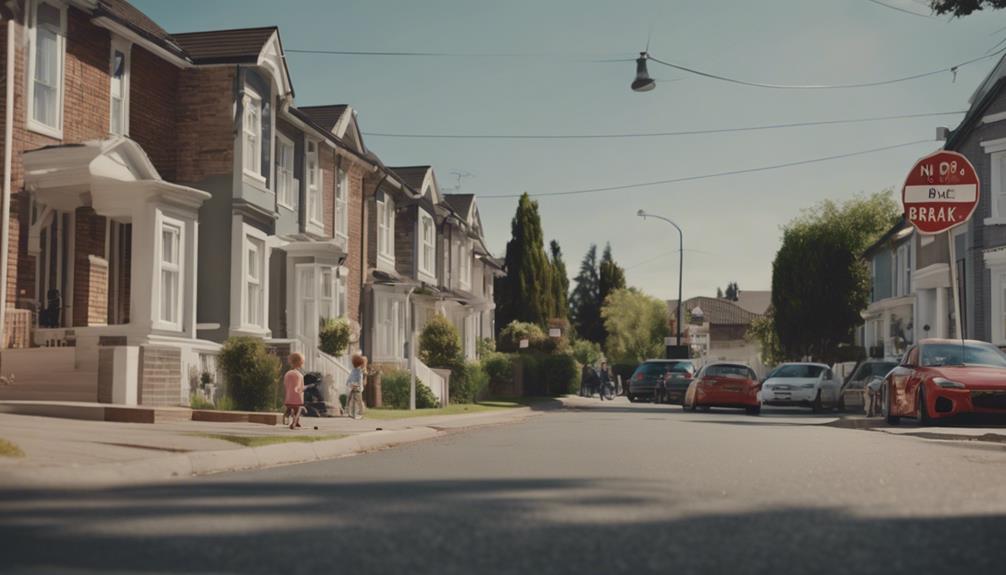Spotting a ‘No Engine Brake’ sign on the road means **not** using engine braking systems there. This rule keeps the area *peaceful* and *safe*. Engine braking slows down a vehicle with the engine’s resistance, but it can be **noisy**, which is why some places ban it. Following these signs **helps keep** things quiet and safe for everyone. Knowing these rules makes one a responsible driver. Curios about the importance and meaning of engine brake signs?
Key Takeaways
- Indicates areas where engine braking is prohibited
- Designed to reduce noise disturbances in residential zones
- Reminds drivers to avoid using engine brakes
- Non-compliance may lead to fines or penalties
- Enhances safety and promotes community peace
Understanding the Engine Brake Function
In our exploration of the engine brake function, we uncover how this mechanism harnesses manifold vacuum to slow down a vehicle, reducing reliance on traditional brakes. Engine brakes work by utilizing the engine's internal components to create resistance, effectively assisting in deceleration.
When you release the gas pedal, the engine's throttle is reduced, leading to a vacuum being formed within the engine. This vacuum restricts airflow, causing the engine to work against itself and slow down the vehicle. For manual transmissions, downshifting to lower gears enhances the engine braking effect, providing additional stopping power.
Truck drivers often rely on engine brakes to minimize wear on brake pads, enhance safety by controlling speeds on descents, and improve fuel efficiency. Understanding how engine brakes function is essential for maximizing their benefits and optimizing vehicle performance.
Importance of Noise Reduction Measures

Implementing noise reduction measures is vital to address the disruptive engine brake noises that can disturb residential areas, particularly during night and early morning hours. Noise pollution caused by loud engine braking can have a significant impact on the quality of life in communities.
When truck drivers engage their engine brakes, the resulting noise levels can be as loud as a machine gun, causing disturbances to residents. To combat this issue, communities install 'No Engine Brake' road signs to regulate the use of these noisy braking techniques.
By implementing noise reduction regulations and encouraging drivers to minimize the use of engine brakes in residential areas, the aim is to maintain peace and quiet in neighborhoods. These measures are essential in mitigating the negative effects of noise pollution, ensuring a more tranquil environment for everyone in the community.
Implications of Engine Brake Restrictions
Considering the impact on community peace and noise reduction efforts, adherence to engine brake restrictions is vital for maintaining a harmonious environment. Engine braking signs serve as a reminder to drivers, especially those of commercial vehicles, to avoid using engine brakes in designated areas.
These restrictions are in place to minimize noise pollution, particularly in residential neighborhoods where loud engine braking sounds can disrupt the peace. By obeying the no engine brake signs, drivers contribute to a quieter environment that benefits all road users and residents alike.
Failure to comply with these restrictions can lead to fines or penalties for violating the regulations. Hence, it's important for drivers to pay attention to engine braking signs and adjust their driving accordingly to promote a more peaceful and serene atmosphere in the community. By respecting these rules, drivers play a significant role in creating a more pleasant and harmonious environment for everyone.
Common Misconceptions About Engine Braking

Let's discuss some common misconceptions surrounding engine braking.
To begin with, engine braking is actually beneficial for your vehicle when done correctly.
Next, the noise associated with engine braking is a normal part of the process and not a cause for concern.
Lastly, understanding different engine braking techniques can help you make the most of this safe and effective method for slowing down your vehicle.
Engine Braking Benefits
Contrary to common misconceptions, engine braking is a beneficial technique that reduces wear on brake pads and enhances safety by allowing drivers to effectively control speeds. By utilizing the engine's retarding forces, engine braking lessens the strain on traditional brakes, extending their lifespan and reducing maintenance costs. This method isn't only suitable for the engine itself but also aids in maintaining safe distances in traffic situations.
Additionally, engine braking proves to be a fuel-efficient strategy, especially for truck drivers, helping to conserve energy during descents and avoiding excessive use of traditional braking systems. Embracing engine braking as a part of driving practice can lead to safer and more economical journeys on the road.
Engine Braking Noise
Engine braking noise is often misunderstood as regular brake noise due to unfamiliarity with the technique. Contrary to common belief, this noise is not caused by the brakes but by the engine itself. The distinct sound of engine braking occurs when the exhaust valves open to slow down the engine, creating a series of loud pops or a machine gun-like sound. Understanding that engine braking noise is a normal part of the technique can help clarify misconceptions about its operation.
| Engine Braking Noise |
|---|
| Not brake-related |
| Exhaust valve opening |
| Loud pops or rapid sounds |
| Normal part of the technique |
Engine Braking Techniques
Utilizing the engine's retarding forces to slow down a vehicle, engine braking techniques offer an alternative method to traditional braking systems. Unlike friction brakes that directly apply pressure to the wheels, engine braking harnesses the engine's power to decelerate the vehicle, reducing the reliance on brake pads.
By manipulating the engine's vacuum and air intake, this technique effectively controls speed without solely depending on external braking mechanisms. Engine braking isn't only a valuable tool for traffic management but also aids in maintaining safe intervals between vehicles, enhancing overall safety on the road.
Understanding and mastering engine braking techniques can greatly reduce wear on traditional friction brakes, prolonging their lifespan and ensuring excellent performance when needed.
Impact on Truck Driver Operations

When approaching 'No Engine Brake' signs, truck drivers must adhere to noise regulations to avoid fines and penalties. This restriction aims to reduce disruptive noise levels in residential areas and maintain community peace.
Understanding the importance of noise reduction measures, braking system limitations, and traffic safety concerns is essential for truck drivers operating near these signs.
Noise Reduction Measures
Implementing noise reduction measures has a significant impact on how we navigate truck driver operations. Excessive loud noise from engine braking can disrupt residential areas. When we engage engine brakes, the noise produced is akin to a machine gun, which can be disruptive and bothersome to those living nearby.
'No Engine Brake' signs serve as a reminder to truck drivers to avoid using engine brakes in these areas, promoting a quieter environment for residents. Understanding the importance behind these signs is vital for us to comply with noise reduction measures and make sure we operate our vehicles in a considerate manner.
Braking System Limitations
Understanding the limitations of engine brakes is crucial for truck drivers to navigate effectively and guarantee safe vehicle operations. When engine brake use is restricted, such as by a 'No Engine Brake' road sign, truck drivers must adjust their braking strategy.
This limitation can mean relying more on traditional braking methods, like brake pads, which apply friction to slow down the vehicle. Truck drivers accustomed to using engine brakes may find this adjustment challenging, especially on slopes where engine braking is typically beneficial.
Traffic Safety Concerns
Considering the impact on our truck driver operations, engine braking limitations can greatly alter our deceleration methods, posing challenges in ensuring traffic safety compliance. The 'No Engine Brake' sign aims to address noise pollution concerns caused by the loud exhaust noises from engine braking systems. This restriction affects truck drivers who rely on engine braking for controlled deceleration in various driving conditions.
Understanding and adhering to the limitations imposed by this sign are significant for complying with traffic safety regulations. By restricting engine braking, the sign prompts drivers to seek alternative braking methods to maintain road safety without generating excessive noise. Hence, truck drivers must be aware of these limitations to operate safely and responsibly while considering the impact of noise on the surrounding environment.
Legal Aspects of Engine Brake Prohibitions

In enforcing engine brake prohibitions, local ordinances or traffic regulations serve as the legal framework for penalizing drivers who violate these restrictions. Truck drivers must adhere to these rules to avoid fines and penalties.
Signs displaying 'No Engine Brake' are strategically placed in areas prioritizing noise reduction and community peace. Municipalities install these signs in response to noise complaints from residents disturbed by engine brake sounds. It's important for truck drivers to understand and obey these signs to uphold road safety standards and show respect for local regulations.
Failure to comply can result in legal consequences, impacting both the driver and the community. By following these regulations, truck drivers contribute to a harmonious environment and demonstrate responsible driving practices.
Therefore, it's essential for all drivers, especially truck drivers, to be aware of and comply with engine brake prohibitions to promote safe and peaceful road conditions for everyone.
Safety Concerns and Alternatives

Engine braking offers a reliable method for controlling speeds and reducing wear on brake pads, addressing safety concerns for truck drivers on the road. However, in residential areas, noise pollution can be a significant issue, leading to the prohibition of engine braking. Here are some safety concerns and alternatives to ponder:
- Noise Control: Engine braking can generate loud noises that disturb residents in quiet neighborhoods.
- Community Peace: Prohibiting engine braking in residential areas helps maintain peace and tranquility for local residents.
- Alternative Brake Techniques: Instead of relying solely on engine braking, truck drivers can use traditional braking methods to slow down.
- Awareness and Compliance: Understanding and adhering to 'No Engine Brake' signs is vital to guarantee the safety and well-being of the community.
Community Responses to Engine Brake Signs

Community responses to 'No Engine Brake' signs reflect concerns about noise pollution, safety for drivers, and the need for regulation enforcement. Residents appreciate the measures taken to reduce noise levels, while discussions often arise among community members about the implications of engine brake usage.
It's essential for both residents and truck drivers to understand the significance of these signs in promoting a safer and quieter environment for all.
Noise Pollution Concerns
Amid discussions surrounding engine brake signs, our focus shifts towards the community's responses regarding noise pollution concerns. When diesel trucks use engine brakes, the resulting loud noise can disturb residents and disrupt the tranquility of residential areas.
To address these concerns effectively, the community has implemented the following measures:
- Installing sound barriers along highways to reduce noise levels.
- Enforcing strict regulations on engine brake usage in residential zones.
- Conducting educational campaigns to raise awareness about noise pollution.
- Encouraging the use of quieter braking systems to minimize disturbances.
Safety Implications for Drivers
Traversing roads with 'No Engine Brake' signs prompts us to adapt our driving practices for enhanced safety awareness. These signs indicate areas where the use of engine brakes is prohibited due to noise concerns. As drivers, it's important to abide by these signs to guarantee the safety of ourselves and others.
Ignoring these warnings can lead to noise disturbances, accidents, or fines. By respecting these signs, we contribute to a quieter and safer environment for everyone. Understanding the importance of these regulations helps us become more responsible drivers.
Enforcement of Regulations
In areas with 'No Engine Brake' signs, it's crucial for drivers to comply with the regulations to uphold safety standards and minimize noise disturbances. When encountering these signs, remember to downshift the engine properly to reduce noise pollution and promote a safer driving environment.
Here are four essential tips for enforcing these regulations effectively:
- Engage in proactive communication with other drivers about the importance of following 'No Engine Brake' signs.
- Educate yourself on the negative impact of engine brakes on noise levels to better understand the reasoning behind these regulations.
- Practice downshifting techniques in advance to smoothly navigate areas where engine brake usage is prohibited.
- Support community initiatives aimed at raising awareness about the significance of adhering to 'No Engine Brake' regulations.
Enforcement of No Engine Brake Regulations

Enforcing No Engine Brake regulations is crucial for minimizing noise disturbances and preserving peace in residential areas. Signs in your neighborhood indicating 'No Engine Brakes' serve as a reminder to truck drivers to refrain from using this loud braking method. These regulations are in place to prevent disruptive engine brake noises that can disturb the tranquility of communities.
Violations of these rules can result in fines or penalties for drivers who fail to comply. By strategically placing these signs, authorities aim to guarantee that drivers are aware of the restrictions and adhere to them, promoting a quieter environment for residents.
The enforcement of No Engine Brake regulations plays an important role in creating a more peaceful atmosphere and reducing noise pollution in neighborhoods. It's important for drivers to respect these regulations to maintain the quality of life for those living in the vicinity.
Future Developments in Noise Control Measures

Research and innovation are paving the way for quieter engine braking systems to reduce noise pollution in residential areas. These advancements in noise control measures aim to create a more peaceful environment for communities affected by loud engine brake noises.
Here are four potential developments in this field:
- Incorporation of Sound-Dampening Technologies: Future engine braking systems may integrate advanced sound-dampening technologies to muffle the noise generated during operation.
- Exploration of New Materials: Researchers are testing novel materials to determine their effectiveness in reducing noise levels produced by engine brakes.
- Optimization of Configurations: Engineers are experimenting with different configurations to optimize the design of engine braking systems for quieter performance.
- Collaborative Efforts: Close collaboration between engineers and environmental experts is ongoing to guarantee that noise concerns related to engine braking are effectively addressed.
These innovations hold the potential to considerably lessen the impact of engine brake noise on residential areas, promoting a more harmonious coexistence between transportation needs and community well-being.
Frequently Asked Questions
What Does No Engine Brakes Sign Mean?
When we see a 'No Engine Brakes' sign while driving, it means that using engine braking systems in vehicles isn't allowed in that area. This sign aims to minimize noise pollution caused by the loud exhaust noise from trucks using engine brakes.
Why Do Some Roads Not Allow Engine Braking?
Some roads prohibit engine braking not for safety reasons but to reduce noise pollution in residential areas. This restriction aims to maintain community peace, especially during quiet hours.
By disallowing engine braking, residents near these roads are spared from disruptive loud noises. This measure is essential in preventing disturbances and addressing noise complaints.
Why Is No Engine Braking Bad?
Using engine brakes in certain areas is problematic due to the loud noises they produce, disturbing residents. These sudden and disruptive sounds can be bothersome to the community.
Prohibition signs against engine braking aim to reduce noise pollution, promoting quieter driving practices. It's essential to respect these regulations to maintain peace and minimize disturbances in residential areas.
Why Are There No Jake Brake Signs?
No Jake Brake signs are posted to curb loud engine braking noise, often disrupting peaceful neighborhoods. Truckers value the safety benefits of engine brakes, but residents prioritize quiet surroundings.
The signs typically appear near hills, red lights, or stop signs where noise is most bothersome. This clash between safety and peace underscores the ongoing debate over these signs in communities.
Residents and truckers continue to navigate this noise pollution issue.
What Does the ‘No Engine Brake’ Road Sign Mean in Relation to Truck Dashboard Symbols?
When you see the ‘No Engine Brake’ road sign, it means that the use of engine brakes, also known as “Jake brakes,” is prohibited in that area. This sign is important for truck drivers to understand in relation to demystifying truck dashboard symbols, as it impacts how they operate their vehicles in specific locations.
Conclusion
Next time you see a road sign that says 'No Engine Brake,' remember that it means you can't use the loud braking system on your vehicle. This sign is there to maintain the noise levels down and guarantee safety on the road.
It's important to follow these rules to respect the community and other drivers. So, when you see the sign, just remember to use your regular brakes and keep the noise to a minimum.
Drive safe!











